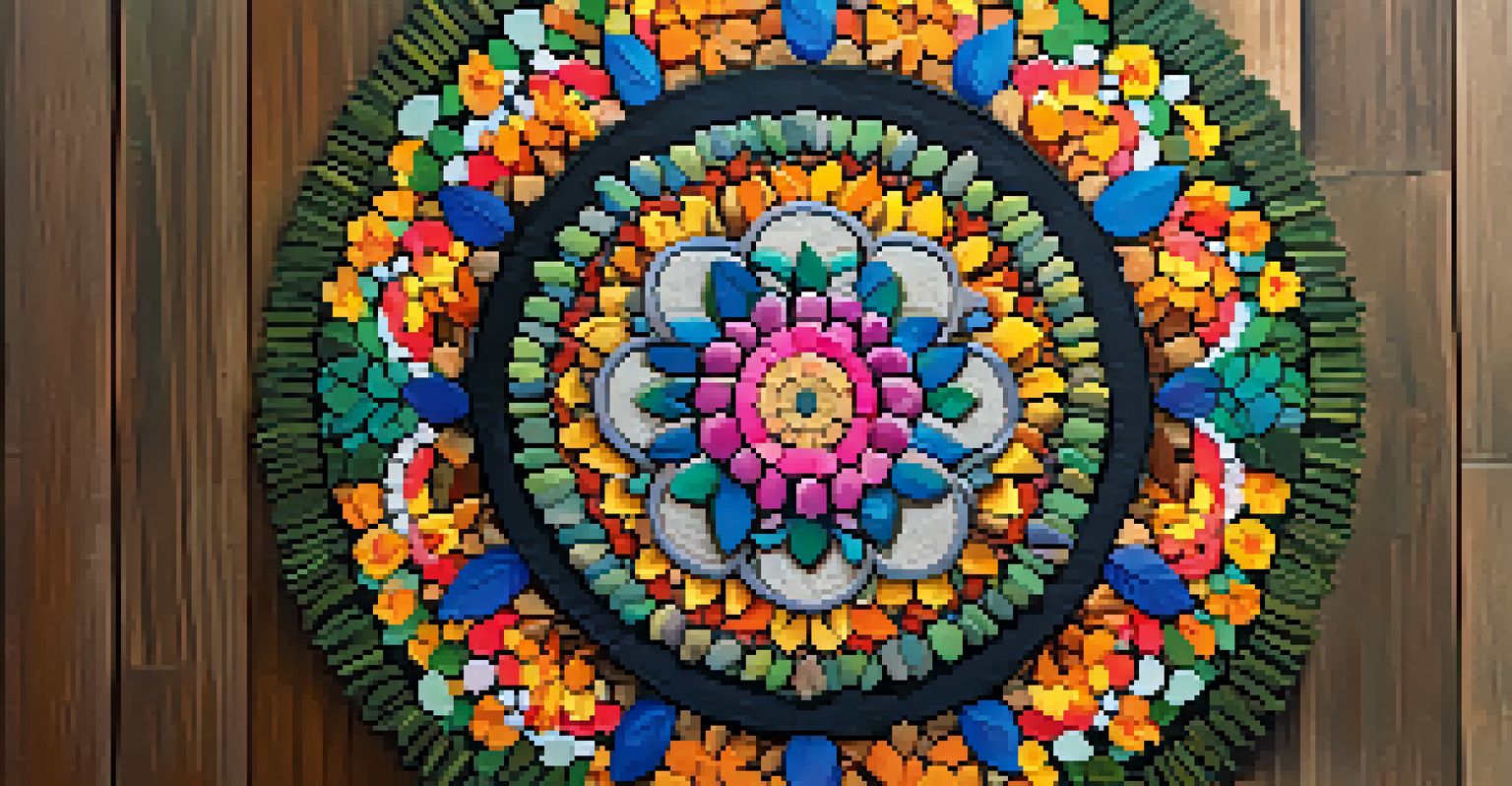Entheogens and Mental Health in Marginalized Communities

Understanding Entheogens: Nature's Healing Agents
Entheogens are psychoactive substances that have been used for centuries in various cultures, often for spiritual or therapeutic purposes. These natural compounds, such as psilocybin from mushrooms or ayahuasca, can alter perception and enhance emotional experiences. By tapping into these altered states, individuals may find new insights into their mental health struggles.
The use of entheogens has been shown to facilitate profound emotional healing and personal insight, especially for those in marginalized communities.
In marginalized communities, where access to traditional mental health resources may be limited, entheogens present an alternative pathway for healing. They can open doors to self-reflection and deep emotional processing, which is vital for those grappling with historical trauma or systemic oppression. The integration of these substances into healing practices has gained attention for their potential to foster resilience.
However, it’s essential to approach entheogens with respect and caution. Misuse can lead to adverse effects, especially for individuals who may not have adequate support systems in place. Therefore, understanding their cultural significance and ensuring safe environments for use is crucial in promoting their benefits.
Historical Context: Entheogens in Indigenous Cultures
Many indigenous cultures have long recognized the power of entheogens for healing and spiritual growth. For example, the use of peyote in Native American traditions illustrates how these substances can facilitate communal bonding and personal insight. This rich history underscores the importance of cultural context when discussing modern applications of entheogens.

In these cultures, entheogens are not treated as recreational drugs but as sacred tools for navigating life’s challenges. They are often used in ceremonial settings, emphasizing the collective experience of healing rather than individual consumption. This communal aspect can be particularly beneficial for marginalized communities seeking to reclaim agency over their mental health.
Entheogens as Healing Tools
Entheogens provide alternative pathways for healing, especially in marginalized communities with limited access to traditional mental health resources.
By learning from these traditions, contemporary practices can be shaped to honor the profound wisdom of indigenous peoples. It’s a reminder that the journey towards mental wellness can benefit from the integration of ancient practices into modern therapeutic frameworks.
The Mental Health Crisis: A Call for Alternative Solutions
The mental health crisis disproportionately affects marginalized communities, where factors like poverty, discrimination, and lack of access to care create significant barriers. Traditional therapy may not always be accessible or resonate with individuals from these backgrounds. This has led to an interest in alternative treatments, including entheogens, which can provide unique benefits.
Psychedelics are a key to unlocking the mind's potential and promoting healing, particularly for those who have been marginalized in society.
Research indicates that substances like psilocybin can produce profound shifts in perspective, helping individuals break free from negative thought patterns. These experiences can lead to increased emotional healing and a greater sense of connection to oneself and others. In a world where mental health resources are often scarce, entheogens offer a glimmer of hope.
Community organizations are starting to explore these alternatives, integrating them into holistic health programs. By providing education and safe spaces for guided experiences, they can empower individuals to take charge of their mental wellness, fostering a more inclusive approach to healing.
Challenges and Risks: Addressing Safety Concerns
While the potential benefits of entheogens are promising, there are also significant risks that must be addressed. The unregulated nature of these substances can lead to unsafe practices, especially in vulnerable communities. Ensuring safety and informed consent is crucial for anyone considering these options for mental health support.
Moreover, without proper guidance, individuals might experience overwhelming emotions or distressing thoughts during their experiences. This underscores the importance of having trained facilitators who can provide support and context. A safe environment can make all the difference in maximizing the therapeutic potential of entheogens.
Cultural Significance of Entheogens
Indigenous cultures view entheogens as sacred tools for healing and personal growth, emphasizing their communal and ceremonial use.
As interest grows, it’s vital to establish frameworks that prioritize harm reduction and education. By doing so, communities can better navigate the complexities of entheogen use while minimizing risks, creating a safer path to healing.
Case Studies: Success Stories from Marginalized Communities
There are inspiring case studies highlighting the positive impact of entheogens on mental health within marginalized groups. For instance, programs that incorporate psilocybin therapy have shown promising results in addressing PTSD among veterans and survivors of trauma. These success stories illustrate the potential for entheogens to catalyze profound changes in mental health.
Participants often report significant reductions in anxiety and depression, coupled with a newfound sense of purpose and connection. These results can be life-changing, especially for those who have felt disconnected from traditional mental health resources. They serve as a reminder of the importance of exploring diverse healing modalities.
Such case studies advocate for a broader acceptance of entheogens in mental health discussions. By sharing these success stories, we can inspire other communities to consider how these substances might aid their healing journeys.
The Future of Entheogens in Mental Health Treatment
Looking ahead, the future of entheogens in mental health treatment appears promising, particularly for marginalized communities. With increasing research and evolving public perceptions, there’s potential for more inclusive policy changes. These shifts could pave the way for entheogen-assisted therapies to become a viable option within mental health care.
As more studies validate the therapeutic benefits, we may see a greater push for integrating these practices into mainstream health systems. This integration could help destigmatize their use, making them more accessible to those in need. The goal is to create a holistic approach that acknowledges both traditional and alternative healing methods.
Promising Future for Entheogens
As research validates their benefits, entheogens may become integrated into mainstream mental health practices, fostering more inclusive treatment options.
Ultimately, the future hinges on collaboration among researchers, practitioners, and communities. By working together, we can develop frameworks that ensure safe, respectful, and effective use of entheogens, fostering a more inclusive landscape for mental health treatment.
Conclusion: Embracing a Holistic Approach to Healing
In conclusion, entheogens hold significant potential for improving mental health outcomes in marginalized communities. By honoring their historical contexts and addressing safety concerns, we can create pathways for healing that resonate with those who have often been overlooked. A holistic approach that integrates these substances can empower individuals to reclaim their mental wellness.
It’s crucial to remember that entheogens are not a panacea; they are tools that require careful consideration and respect. When used responsibly and in conjunction with traditional therapies, they can offer new avenues for insight, connection, and healing. This balanced approach can help bridge the gap in mental health care for marginalized populations.

As we move forward, fostering open dialogues about entheogens and mental health will be key. Together, we can create inclusive spaces that embrace diverse healing modalities, ultimately leading to healthier communities.